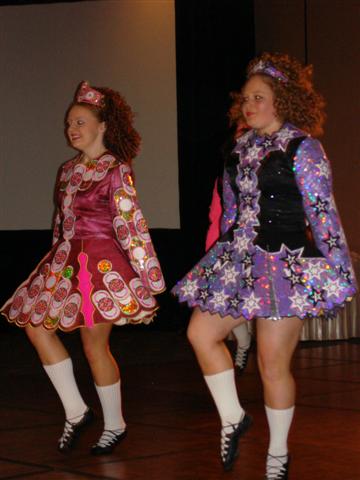Although Scottish men in skirts playing bag pipes can be very interesting, Irish dancing is a whole different story.
Irish dancing has evolved into a competitive and popular form of dance. The dancers practice vigorous hours each week to perfect their routines for competitions and performances. While Irish dancing, the dancers must keep their arms at their sides at all times; making it difficult to lift off the ground when doing tricks.
“There’s a lot more to it then people see. They just think of the bag pipes and men wearing skirts,” Irish dancer Jennifer Finney, junior, said. “Irish dancing is the hardest type of dance I’ve ever done and takes every muscle in your body.”
Finney has been Irish dancing for twelve years and was first interested by it when she was in first grade. Kelly Finnen, sophomore, is also an Irish dancer who has been dancing for eleven years.
“I like to do a lot of shows and perform for other people as well as spending time with my friends,” Finnen said. “I really enjoy competing with my team, I have met a lot of new people and it has taught me leadership skills, responsibility, and how to deal with challenges in order to succeed.”
Competitions are a major part of Irish dancing. The dancers can perform at local competitions, also known as Ceises, which help them in preparing for the top competitions.
“Competitions like nationals and regionals are called orreachtas, and you have to be at a certain level to make it,” Irish dancer Tara Kennedy, junior, said. “I’m going to nationals this year over summer.”
Kennedy is going to nationals for a group dance and some solo dances as well. Nationals and other top competitions are at times located all around the world.
“The coolest place I have gone to, for Irish dancing, is Glavco, Scotland,” Finney said. “We went there for worlds, and it was lot of fun. The coolest part was receiving a worlds medal.”
At these competitions, dancers can perform solo, group, or both at the competitions. Usually the dancers compete in solo dances at the higher competitions.
“Competitions can be very hard because they are so subjective,” Finney said. “You could have a perfect routine, but the judges could decide not to place you that day.”
Irish dancers practice vigorously for hours each day to continuously improve their skill level.
“The hardest thing about Irish dance is probably learning and mastering steps,” Kennedy said. “I practice two to three hours two times a week, and then you have to practice on your own time each day.”
Another important aspect in Irish dancing is entertaining. Irish dancers can travel around in their communities and go to different events or places to perform.
“Especially throughout March, we go to perform at places like nursing homes, schools, and parties,” Finnen said.
The month of March and St. Patrick’s Day is like the Super Bowl Sunday of Irish dancing, and different dance companies and dancers perform many kinds of events and places.
“On St. Patrick’s day, you might see dancers in parades and festivals like that on St. Patrick’s day.”
Depending on the event Irish dancers wear either their solo dress or group dress. They also wear wigs to go with their uniform, which can sometimes cause problems.
“The wigs are more annoying than anything,” Finney said. “Once I was on my last round of the competition and my wig came off while I was dancing.”
Wardrobe malfunctions can be an issue, but regardless, Irish dancing has become a source of entertainment and a challenging style of dance for dancers all over the world.
“I love to travel to different competitions all over,” Finney said. “I just love being able to see my friends and get to experience all these new things in different countries.”

